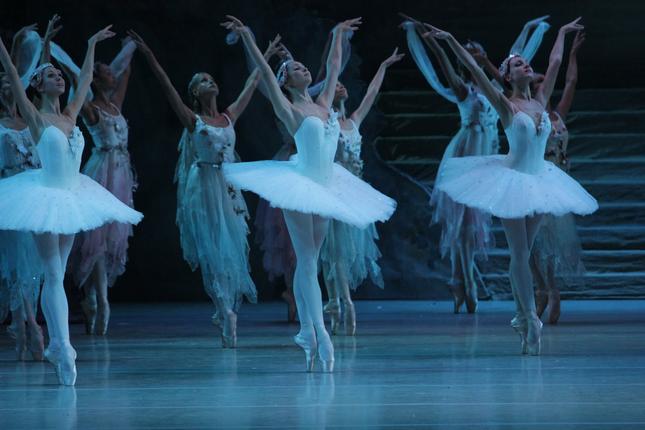‘Raymonda’: the Power of Technique, Emotion and Tradition
By • March 30, 2016 0 1207

When most people think of ballet or call up memories of it, they do not think of dance. They think in pictures and movement—a stage full of shimmering ballerinas in white en pointe or a prima ballerina lifted into the air as if preparing for flight, solos and pax de deux and divertissements, those often spectacular splashes of costumed dancers offering eye-popping entertainment that has little to do with the plot proceedings, but are there for the wow factor.
We’re talking about classical ballet — “Swan Lake,” “Giselle” or “The Sleeping Beauty” — powered by gorgeous music from the likes of Tchaikovsky and others, and danced right out of the inspirational, emotional and technical toolbox of classical ballet. This kind of ballet — pre-Balanchine, pre-Graham and certainly pre-Morris — is ballet as throwback, its sturdiest, most definable and recognizable and appealing, and also its most Russian, in many instances.
The Mariinsky Ballet out of St. Petersburg, Russia, which was turned into a major force by the legendary choreographer Marius Petipa in the late 1800s is classical ballet at apex. If you want to dive into that particularly hypnotic pool, the Mariinsky production of Petipa’s “Raymonda” at the Kennedy Center’s Opera House through Feb. 28 is, if not entirely the most outstanding, certainly one of the most characteristic examples of the form.
You have to want to swim in this ocean, and it’s a long, exhausting swim—three acts, roughly three hours. For the most part, it’s worth it because you get to see a kind of spectacular final product and the nuts and bolts of the process. The ballet vocabulary of duets, of pose and poseur, of difficult athletic feats turned into delicate pictures and motions, into dance, the tutu skirts, so other worldly but also immediate identifiers of what world you are in. We view the display of arms and legs just so, acting in the midst of dancing tells you a lot about what it takes to live in that world and the ultimate reward of creating difficult and delicate beauty.
“Raymonda” — the name of the medieval Hungarian princess over whom a prince and knight and a Saracen intruder battle over — is still an example of the same old stories, a fight for love and glory in a kingdom far, far away (Hungary, as it happens), in a time long, long ago (the Late Middle Ages, as it happens).
Here, Raymonda (a lithe, at once steely and fragile Oxana Skorik) lives at the Hungarian court, awaiting her bethrothed, Rene de Brienne, (Soslan Kulaev), a dark-haired, bold knight whose portrait comes alive while Raymond dreams of him. On hand also is Abderakhman, the visiting Saracen chief who plots to abduct Raymonda with his retinue of slaves and servant.
Act one is like a long introductory play—courtiers, solos by two energetic dancers, retinues marching, moving and dancing, Raymonda showing off her dancing chops and so on. Act two ends in a decisive to-the-death duel between Rene de Brienne and Abderakhman, and act three is a celebration and one long series of wonderful danced divertissements which cater to Hungarian musical flavors and in which Oxana Skorik shows off all of Raymonda’s considerable qualities.
“Raymonda,” to me, is about elevation, trust—in her partner—the use of hands and fingers, the ability to make muscular strength seem as strong and moving as a leaf. The spectacle in the last act is spirited, its meant as eye candy and the dancers, instead of traditional ballet wraps, have what look like very contemporary-styled shoes.
Contemporary is not the watchword here. It’s the release of tradition of classical forms, classical music by Alexander Glazunov, which has its own stand-alone qualities. Here, it serves as a rich and pleasant part of the whole, if not an overpowering force.
This production of “Raymonda” serves the time-honored glories and pleasures of classical ballet. It seemed perfect for the audience on hand, which included older couples, single moms with budding ballerinas in glittery outfits, all sorts of couples, the young and the old, the aficionados discussing both glaring and small errors, the joys of the principal dancers, as well as dealing with the length of things.
As Tevye sang: “Tradition. Tradition.”

